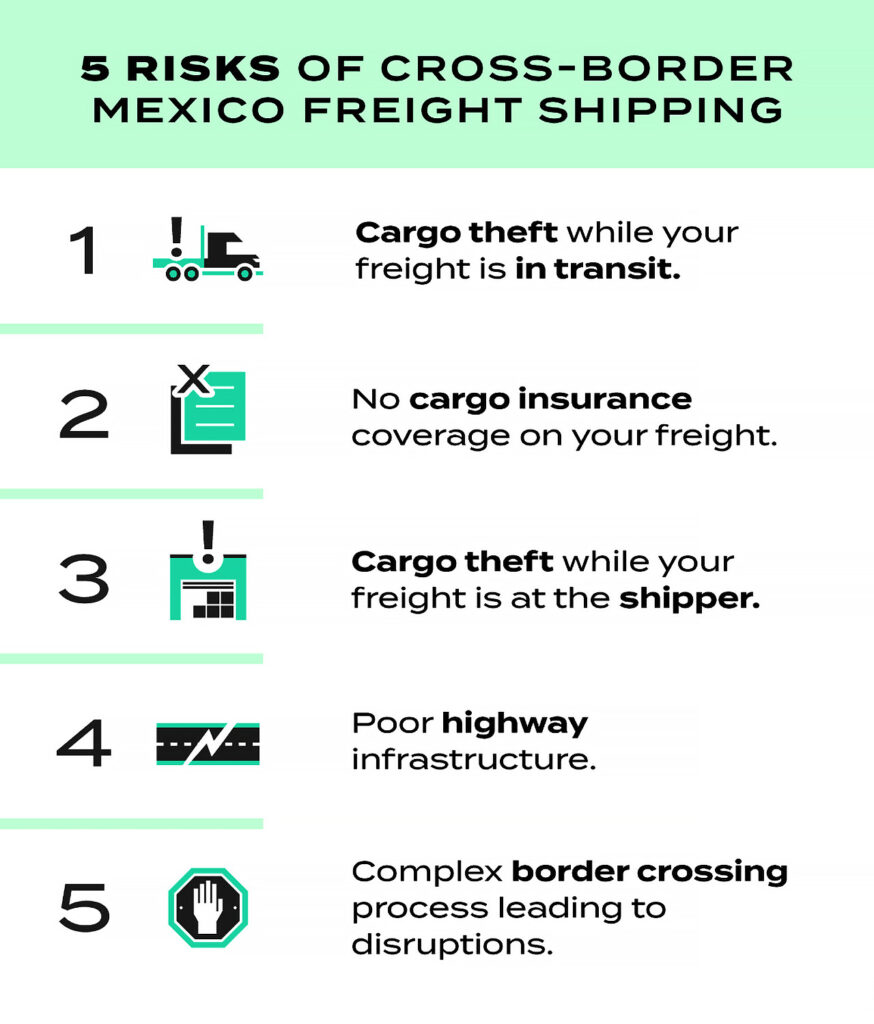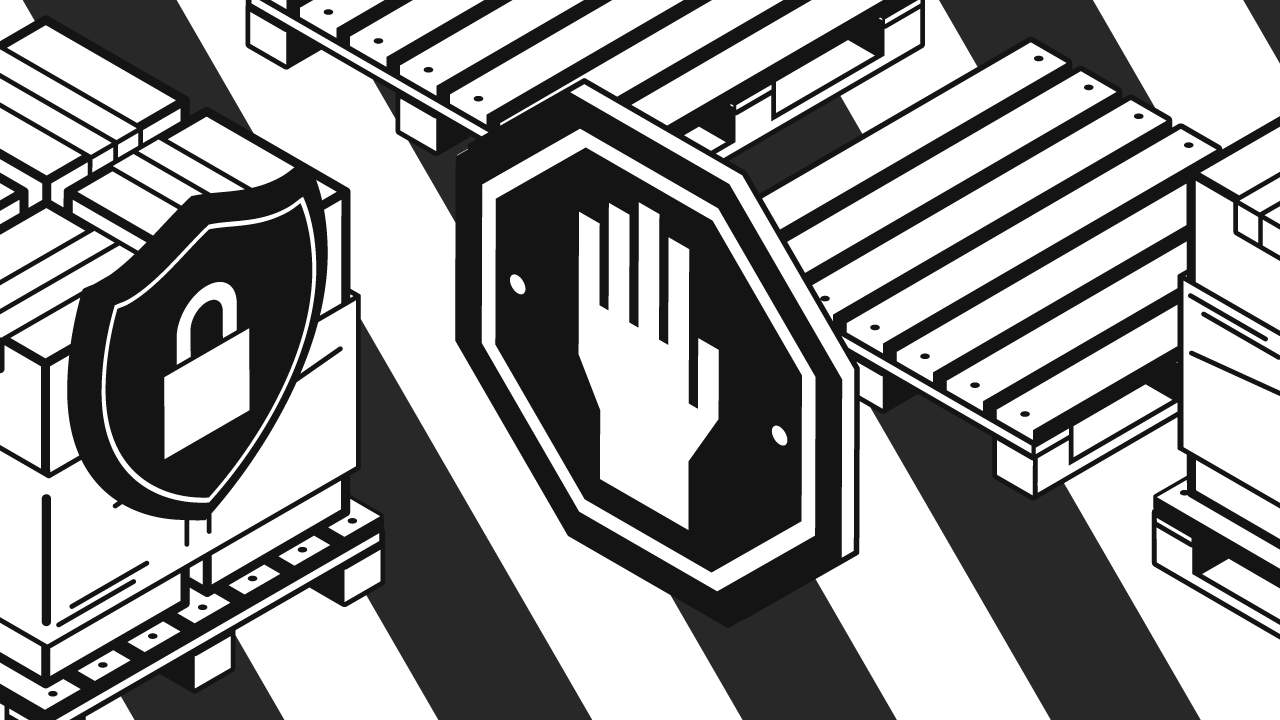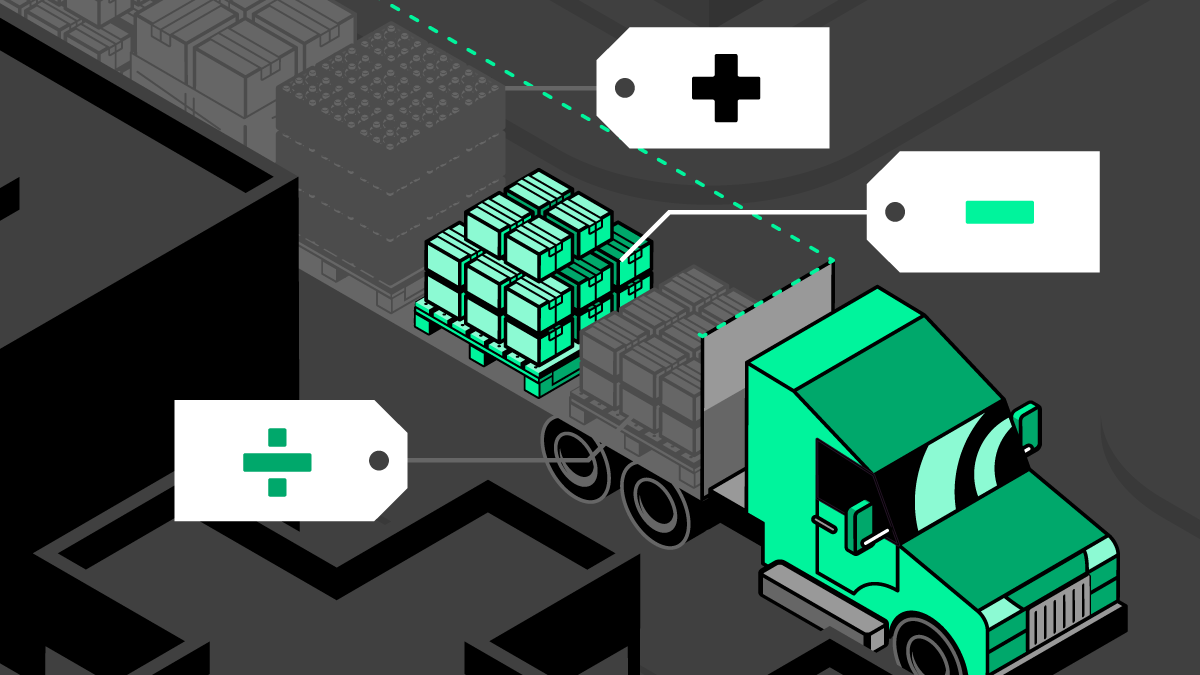Trade between the U.S. and China gets a lot of headlines, but did you know that our largest trading partner is actually Mexico?
Every day, nearly 35,000 trucks cross the Mexico-U.S. border.
Though a vast majority of shipments move without issue, shipping in Mexico has unique risks compared to the U.S. or Canada.
If you understand some of these key threats to cargo security, you can take simple steps to help avoid issues.
Read about some of these risks and learn what you can do to protect your freight when shipping across the southern border.
5 Risks of Mexico Truckload Shipping & Ways to Protect Your Freight

Risk #1: Cargo theft while your freight is in transit.
In 2022, there were more than 20,000 instances of cargo theft on Mexican trucks and trains.
And unfortunately. it’s trending up, with the number of incidents increasing 18% from 2019-2022.
How does that compare to the United States? According to Overhaul, there were 1,090 incidents of cargo theft in the U.S. in 2022, which is only about 5% of Mexico’s total.
Cargo theft is more common in Mexico.
- Mexico: +20,000 annual incidents
- United States: +1,000 annual incidents
In Mexico, cargo is most frequently stolen by hijacking.
Food and beverage products are very popular with thieves, representing about 40% of the cargo stolen from trucks, according to industry estimates.
Criminals also are getting very clever in their use of jamming devices and other tools to avoid detection.
Though the Mexican government has stated its increased focus on cargo theft, shippers have to be proactive in protecting their freight.
How to protect your cargo:
- Know who is moving your freight within Mexico.
Use multiple sources to verify and validate carriers to make sure they comply with all rules and regulations. They should be instructing drivers to take safer routes and where to stop for breaks and fuel. CTPAT carriers are the most reliable when it comes to security procedures; make sure your provider has concrete policies in place to protect your freight. - Assess risk by lane and route.
The number of high-risk areas is increasing and certain highways have emerged as top targets for cargo theft — work with an experienced provider that has a planned route that avoids higher risk areas. Some shippers even change routes and schedules to avoid establishing predictable routines. - Pay attention to timing.
Avoid having a driver leave the shipper at night or driving through the night in high risk areas — most theft occurs between 10:00 pm and 5:00 am. To mitigate risk, have the driver lay over at the shipper or a truck stop. - Get as much visibility as possible.
Make sure carriers are using GPS and other technology to monitor shipments in real-time and provide visibility. Work with providers who have contacts available after hours so you can get eyes on your freight at any time. - Consider hiring escorts to follow shipments.
They create the driving route, approve all stops and monitor trailers.
Risk #2: No cargo insurance coverage on your freight.
Despite the high incidence of cargo theft, Mexican carriers are not required by law to carry cargo insurance, and the vast majority do not.
There’s little incentive for carriers to buy insurance because they are liable for a very small amount if a shipment is stolen or damaged, regardless of the cargo’s value.
How to get coverage for your freight:
It is important for shippers to have an insurance policy that covers freight while it travels in Mexico.
Some carriers may offer some type of coverage at a premium, but it is still important to have your own policy.
Ask your current domestic provider if they have a blanket or “marine” policy that covers Mexico.
The right cargo insurance can protect your assets, preserve your reputation and even enhance your client relationships.
You will likely need your own cargo insurance — Mexican carriers are not required to carry it, and most do not.
Risk #3: Cargo theft while your freight is at the shipper.
Criminals exploit any weak links in the supply chain, including warehouses, truck stops and other facilities.
Criminal organizations have been known to send members to work in warehouses to get useful information that may enable cargo theft in the future.
How to protect your freight:
Become familiar with the safety protocols for loading and unloading.
Many facilities in Mexico require carrier information ahead of shipping so they can become familiar with who will be picking up or delivering at their docks.
They will also often have specific instructions for drivers entering their facility, trailer requirements, and what documentation the carrier will need to bring.
If you are transloading freight, which is a safe and secure way to get goods across the border, make sure you work with trusted providers who can handle freight with care.
Make sure your shipping facility takes cargo security and cargo theft just as seriously as your carriers.
Risk #4: Poor highway infrastructure.
The quality of the roads in Mexico is much lower than in the U.S. or Canada.
Mexico ranked 49th out of 141 economies in the quality of its road infrastructure, according to the World Economic Forum’s 2019 Global Competitiveness Index.
For comparison, Canada was 30th and the U.S. was 17th.
How to mitigate risk:
Proactively plan your shipment journeys to find the best routes and avoid delays.
Some carriers instruct drivers to use toll roads because they are fast and bypass smaller towns.
And while toll roads can be expensive, many insurance providers in Mexico will not cover freight that doesn’t move on them.
Risk #5: Complex border crossing process leading to disruptions.
Numerous parties are involved to get freight across the border, including multiple carriers, customs brokers and possibly transloading facilities.
There could be disruptions at any of these touch points, which could lead to late deliveries and damage customer relationships.
Border crossing is already a time-consuming procedure. Wait times for trucks exporting freight from Mexico to the U.S. can range from 3-12 hours depending on the crossing location and other contingencies.
How to mitigate risk:
When there are numerous parties involved, you have to plan your shipments well ahead of time.
By working with a trusted provider, you can build a realistic transit schedule.
Also, make sure your paperwork is in order and you have a trusted customs broker to keep the border crossing as smooth as possible.
Communication and coordination are generally more complex, so it’s essential to streamline touchpoints. In fact, lack of planning is one of the biggest cross-border mistakes we see shippers make.


